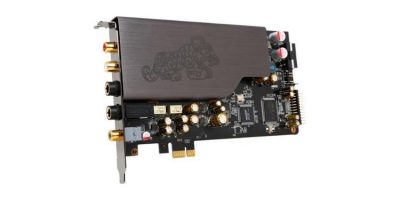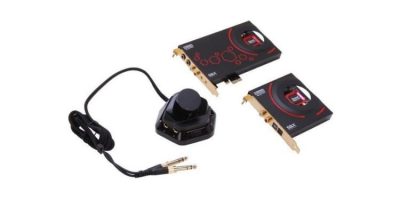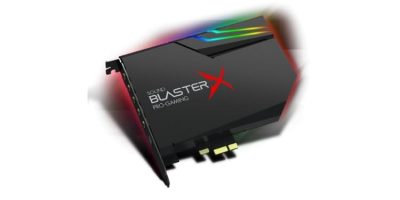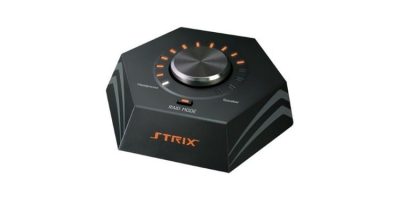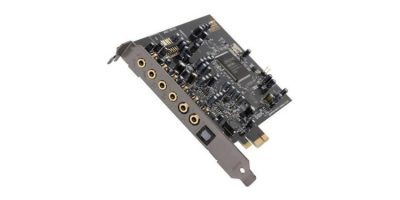Best Sound Card In 2021! (Gaming, Budget, Audiophile)
Here We Are With The Best Sound Cards For Gamers, Music Listeners, And Audiophiles Alike
- Last Updated Apr 29, 2021
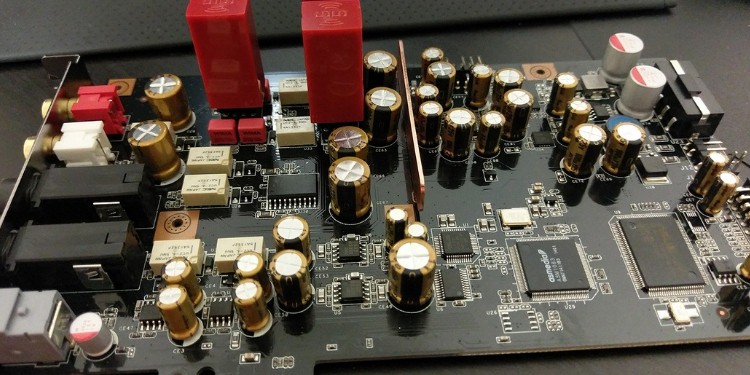
The integrated audio output of newer computer motherboards have improved a lot over the years. So much so, in fact, that for the average gamer, you wouldn’t really need an audio card.
However, if you are an audiophile, dedicated esports gamer, or just looking to make your own media center, then there is definitely some value to be had here. Dedicated sound cards provide far more sound clarity along with other features like headphone amplification, noise-free recording, and, most of all, high-end lossless audio quality.
Buying a sound card is a difficult thing to do for a lot of reasons. One, there are many industry standards and so many specifications. Two, most PC gamers are not overly familiar with audio-related terminology. Therefore, we have put together this guide for newcomers to the audio industry so that you can experience the best of the best.
Products at a Glance
Best Sound Card In 2021! (Gaming, Budget, Audiophile)
Offers True 7.1 surround sound
Provides additional OpAmp for swapping
A bit pricey
We are starting our list with the most powerful 7.1-channel internal sound card of all time: the ASUS Essence STX II. It is an audiophile-grade industry-leading sound card, which comes at a hefty price.
It is composed of two components: the main board, which provides outputs for Front, Headphone-out, Line-in, and S/PDIF; and the daughter board, which provides six RCA jacks for multi-channel surround sound devices. You can buy the main board by itself, though, if you so wish.
The sound card uses a 4-pin Molex connector for extra power, which is connected to the main board. The main board uses PCM1792A DAC while the daughter board uses PCM1796 DAC. These DACs are high-quality components with an SNR of over 122 dB and provide 24-bit/192-kHz audio.
There are three OpAmps on both the main board and the daughter board, which are swappable, and there are three extra OpAmps available in the swap kit. The main board also provides a high-quality headphone Amp with a maximum supported impedance of 600-Ohms.
The software controls of the sound card are pretty straight forward and offer controls for the output selection, mixer, effects, and some predefined DSP modes. The channels can be configured to operate in the virtual 7.1 mode while providing a great customization experience. There are four ranges for the headphone amplification and they should be chosen accordingly to prevent damage to the headphones (or your ears).
Overall, this audiophile sound card provides staggering audio quality with a major focus on music quality. No doubt, this is easily one of the best sound cards for music, as well as gaming, but it is pricey.
As all things should be, quality doesn’t come cheap. And if you’re looking to pair this with one of the best headphones, consider buying only the best audiophile headphones to maximize the quality of the audio output.
Tons of audio-processing capabilities
Audio Control Module provides a great facility
No 7.1 surround sound despite high price
Creative is a name that is widely known for its PC sound cards, as it is one of the oldest companies when it comes to PCIe audio cards. This is especially true of their Sound Blaster line of sound cards with the Creative Sound Blaster ZxR being the company’s latest flagship sound card.
The sound card provides two boards, just like the Asus Essence STX II, along with an Audio Control Module (ACM). The mainboard provides outputs for Mic, Headphone-out, Front Left and Right, Rear and the Sub/C while the daughter board provides Aux-in and Toslink Optical S/PDIF-in and S/PDIF-out.
Sound Blaster ZxR uses the SoundCore3D chip replacing the X-Fi chip in the older models. The PCM1794 is used for headphone-out and Front-out while PCM1798 is used for Rear and C/Sub. The sound card also provides swappable OpAmps like the Essence STX II, although there are no extra OpAmps in the box. The headphone Amp provides support for headphones with impedance ranging from 32-Ohm to 600-Ohms.
The Sound Blaster Pro Studio suite provides many features dedicated to gaming, such as: surround sound, Crystalizer, and smart volume. There are two headphone amplification settings, the 32-300 Ohm setting and the high-gain setting for 600-Ohm headphones.
Perhaps the worst part about this card is that it doesn’t have 7.1 surround sound support. This is obviously a big bummer 7.1-channel home-theatres are getting increasingly more popular. It’s also an odd decision since it’s still priced like the premium card that it is. In some ways, it’s kind of sad to see that this great card is just not viable for a huge sect of the consumer base that will be using 7.1 systems.
Overall, we believe that this PCIe sound card is a great alternative to the Essence STX II, with better gaming features… but no 7.1-channel support.
High-resolution playback
Aurora RGB lighting
Molex power connector required for RGB
The Creative Sound BlasterX AE-5 is Creative’s latest addition to the gaming-oriented sound cards and it’s packed with features. First and foremost, while this is insignificant in the grand scheme of things, this is a nice looking card. This is largely due to its Aurora Reactive Lighting System, which makes this the first sound card with a built-in RGB controller.
The RGB does require a Molex power connector to power, which is an unfortunate requirement that you need to be aware of before investing in it. The sound card itself functions just fine without the additional power, though.
Like the Creative Sound Blaster ZxR, this sound card also does not feature 7.1-channel support, which is still disappointing, but not nearly as much so since it is significantly cheaper.
The sound card features one of the latest Sabre DACs with 32-bit 384-kHz playback and an SNR of 122 dB. Moreover, Sound Blaster has created a new methodology for headphone amplification. Called XAMP, the amplification is done on both headphone channels, supporting headphones with impedance-range of 16-600 Ohms. The most notable feature of the sound card is the inclusion of Scout 2.0, which greatly aids the user during competitive gaming.
We believe that this computer sound card is a must buy for people who want to experience the best in terms of competitive gaming, as its software features make it the best sound card for gaming, although it does not support true 7.1-channel surround sound.
Offers 7.1-channel surround sound at a cheap price
The volume control box provides ease of use
Lower SNR than that of similarly priced cards
ASUS Strix RAID PRO is from the Strix lineup of sound cards, which are made for gamers, unlike the Essence series (seen with our first pick). Strix RAID PRO features two main components: the sound card and the additional volume control box.
The sound card provides a total of seven 3.5mm jacks, with support for 7.1-channel devices, box-link, mic-in, line-in, and S/PDIF-out. The sound card requires additional power apart from PCIe power, which it receives through the 6-pin power connector.
The sound card features ESS Sabre9006A DAC, which supports up to 24bit 192-kHz playback with an SNR of 116 dB, which could have been a bit higher like the similarly priced BlasterX AE-5. The sound also incorporates a dedicated headphone amp, supporting headphones with an impedance-range of 16-600 Ohms.
The Strix Sonic Studio software provides many options to customize the audio such as Compressor, Perfect Voice, Noise Gate, and Voice Clarity. The sound card also supports the virtual 7.1 surround sound, with great control over the channel positions.
Overall, this gaming sound card rivals the features of the Creative Sound BlasterX AE-5. While the AE-5 arguably offers better sound clarity, this supports 7.1 Surround Sound and has its snazzy volume control box.
Cheap price for the features
Buggy drivers
Only three outputs for 7.1-channel devices
Here we are with another Creative product: the Creative Sound Blaster Audigy RX 7.1. This sound card is much cheaper than the previously mentioned sound cards, but this is at least partially due to the fact that it’s an old product. However, if you’re thinking that means it’s worse you’d be wrong as it provides sound quality that’s good enough to diminish the lines between a high-end and low-end sound card.
It features six 3.5mm jacks and one Toslink optical S/PDIF-out. The card features 7.1 channel support but provides only three output ports, which is why you might have a hard time connecting 7.1 channel devices.
The DAC of the sound card features 24-bit 192-kHz playback, while having an SNR of 106 dB, which is quite lower than other sound cards. The sound card features the famous CMSS-3D positioning audio algorithm; however, I think the CMSS-3D is more a gimmick than an actually beneficial feature, so take from that what you will.
To conclude, this audio card might not be the best sound card out there but at this price point, you won’t find anything better.

